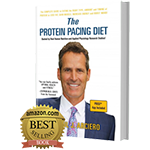Thirty years of nutrition and metabolism research has taught me two main lessons: 1) our bodies thrive on a diet consisting of 25% to 40% lean, healthy protein (from both plant and animal sources), along with at least 25% healthy fats and oils and lots of fresh veggies, certain whole grains and fruits, and 2) performing a combination of exercise routines, as opposed to just 1 or 2 different types, on a weekly basis results in drastic health and physical performance improvements.
These two scientific facts are the foundation of my Protein Pacing diet and PRISE exercise protocol. Specific to Protein Pacing, this diet provides significant health benefit, especially if each meal contains a quarter to a third protein (Arciero et al, 2008; 2013; 2014).
Yet there are still some non-believers. Despite my published research, as well as research by others that supports a protein-rich diet, a recent article in the New York Times “The Myth of High-Protein Diets,” written by a well-known cardiologist (Dean Ornish, MD) cites a limited perspective of current dietary intake trends and the obesity epidemic using data from the Agriculture Department from the period 1950 – 2000. In stark contrast, more recent peer-reviewed scientific data paints a much different picture of food intake trends and prevalence of obesity among Americans from the period 1970-2010 (Am J Clin Nutr: 2011,93:836-43; 2013;97:848–53). While both sets of data agree that food intake increased approximately 200 calories per day during this time period, the source of where those additional calories came from differs drastically.
Ornish places the blame on fat and protein. But the published data clearly shows Americans ballooned after eating too many carbohydrates during this time period. In fact, current research data strongly supports that for every 1% increase in calories from protein and 1% reduction in carbohydrate calories, overall food intake may decrease by 33 calories a day! In other words, the more protein you eat, the less total calories you consume and the more likely you will lose weight and improve your health.
Protein holds the key to weight loss. Several recent intervention studies from our laboratory at Skidmore College provide strong support for eating a protein-rich diet—think a quarter to a third of your daily calories –to decrease total body weight and body fat (including abdominal fat) while improving cardiovascular and metabolic health. Our study diets range between 25-35% high-quality animal and plant-based protein that emphasize foods such as nuts/seeds, legumes, beans, pea/rice protein powder, free-range eggs, grass-fed dairy products (milk, Greek yogurt, cottage cheese, whey protein powder), wild fish, grass-fed beef.
In a lab, this can be easy to control for, but from a practical standpoint, relying on only plants to meet your daily protein requirement can become a full-time job. For example, sound science has proven 4 or more protein meals per day containing a minimum of 20 grams of protein optimizes protein synthesis, quenches hunger, and stimulates metabolism in people under 60 years of age, all of which helps maintain an ideal body composition. Relying on only plant-based foods to meet this translates to 3 ½ – 5 ½ cups of cooked spinach, 1-2 cups of cooked lentils, or 2 ½ – 4 ½ cups of quinoa per meal. If you add physical activity and exercise to the mix, or an age of 60 an older, you would require even more (up to 40 grams of protein per meal).
Meat is a vital protein source, and one that should be embraced. The important thing is to shop for meat with the same care many people put into shopping for vegetables: with a focus on “quality.” Not all animal meat is created equal. It is well known that differences exist between the “quality” of animal protein from conventional production facilities where the animals have been grain-fed in feedlots or cages versus free-roaming and pasture-/grass-fed. Grass-fed beef has a greater amount of heart-healthy omega three fatty acids. This is the case for most animal protein sources, including milk, eggs, pork, and fish. Humanely treated and “in-the-wild” animal sources provide a healthier source of nourishment. This quality of animal protein also supports local farmers which is great for the community and the environment.
As leaders in healthcare, we need to be more inclusive (not divisive) and promote a balanced nutritional eating landscape that doesn’t alienate one food group from another. A balance of high-quality nutrient-dense whole foods from local and/or organic plant and animal sources are best for optimal health. Both animal and plant based diets provide superior health benefits. We just need to focus on the “quality” of the source of each and find more harmony in our nutritional recommendations.

